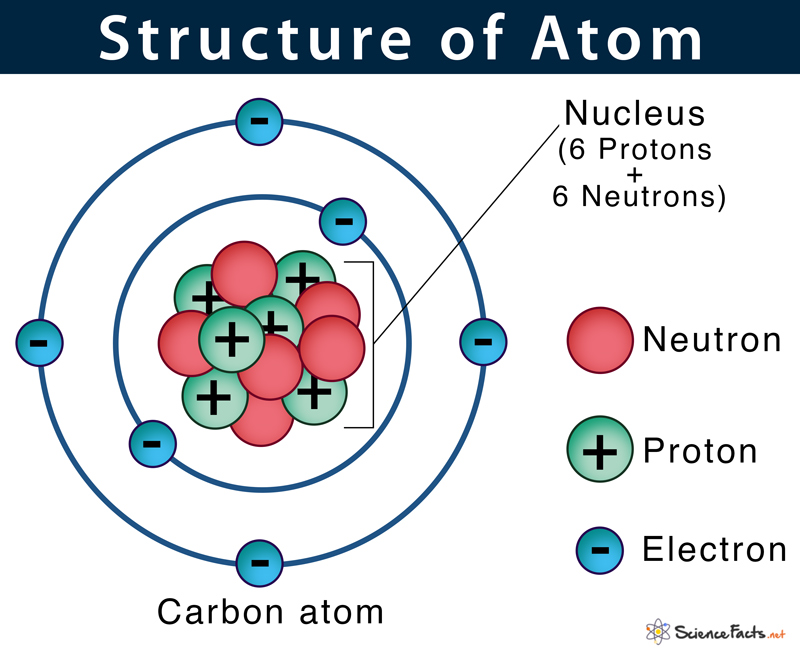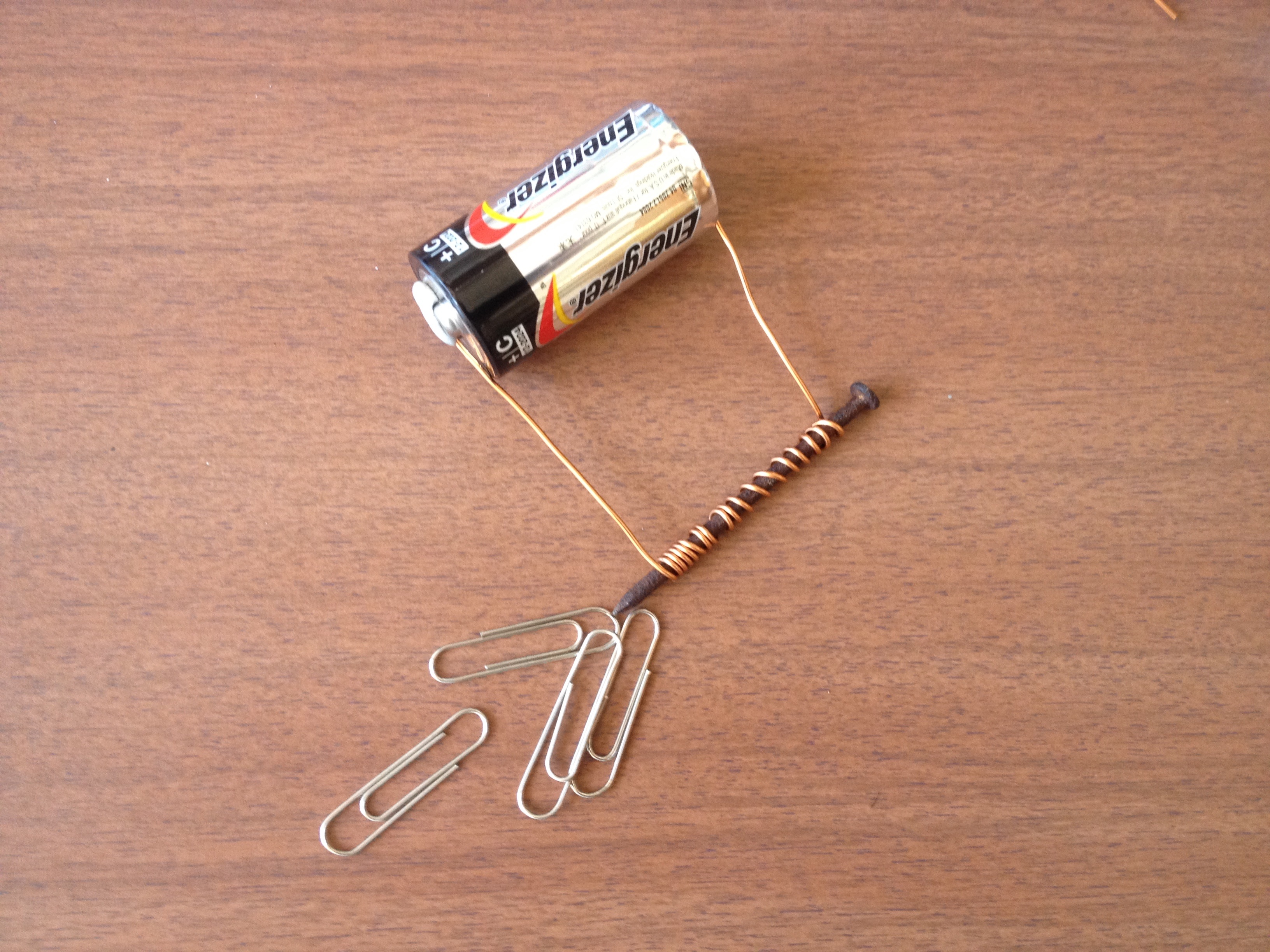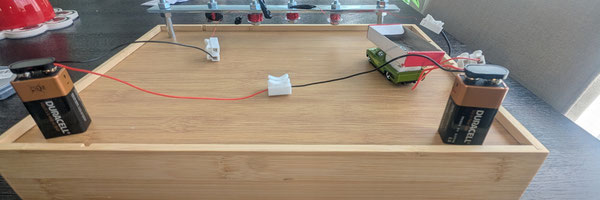Electromagnetic Coils
Grade 6
Presentation
Hypothesis
Atoms are really small spheres that make up everything. Inside of an atom is a nucleus. A nucleus is made up of protons and neutrons, with electrons circling around it. When electrons jump from one nucleus to another, it creates electricity, which can shock us.
Research
Atoms are really small spheres that make up everything. Inside of an atom is a nucleus. A nucleus is made up of protons and neutrons, with electrons circling around it. When electrons jump from one nucleus to another, it creates electricity, which can shock us.

An electromagnet is a type of magnet that’s strong. It’s basically a solenoid with an iron core. Don’t get it mixed up with a magnet though! The difference between electromagnets and magnets is, electromagnets can be turned off, making it so preferable. A solenoid is a wire that is in a coiled up shape, and an iron core is like a screw or metal bar. It looks like an iron bar with a flat surface at the bottom, (allowing stuff to stick properly) with insulated copper coils wrapped around. The reason we use copper instead of other things is because copper is a good conductor of electricity - meaning that electricity can easily flow through copper.

An electric current that is generated by a battery or power source, travels through a copper wire, creating a magnetic field. The direction the current flows in, determines the direction of the magnetic field. For example, when the copper wire is straight, the current flowing through it will make the magnetic field circle the wire. When it is curled up, the magnetic field goes in a straight line - with one side of the solenoid turning into north pole, and other side south pole.

It is also possible to reverse magnetic field by reversing the direction of current. This can be done by reversing the ends of the solenoid that is connected to the battery. When the current is flowing, electromagnets act like magnets, and when the current stops travelling, the coils are no longer magnetic. Electrons travel through the wire, which creates a magnetic field that goes in circles around the wire. The power of an electromagnet can be varied by changing current.
William Sturgeon (May 22, 1783 - Dec 4 1850) was an electrical engineer, who made the first functioning electromagnet. The invention led to the creation of telegraphs, electric motors, and more. The phenomena that causes an electromagnet to work was discovered by Hans C. Orsted, in 1820. Many scientists followed that discovery, until William Sturgeon built the world’s first functioning electromagnet. This can lift many things such as, iron, nickel, cobalt and magnetite. Anything that’s ferromagnetic can be lifted. Ferromagnetic means that it can be attracted to magnets by a magnetic field. Ergo, things that are ferromagnetic are able to magnetize with electromagnetsThis can be used for cars, TVs, MRI and CT scan machines, elevators, lawn mowers, etc. Since electromagnets convert electricity to magnetism, and electric motors convert magnetism into electricity. For example, MRI machines work by using powerful electromagnets that it causes the protons to align with the magnetic field that is produced. In your own house this can be very helpful in that aspect.
Variables
Manipulated: The coil amounts of each electromagnet
Responding: The amount of weight lifted
Controlled:
- The materials used to test and to build the electromagnet (Different materials can impact the functionality of the electromagnet, varying the results.)
- The power source used to power each electromagnet (If the power source is varied, no matter which electromagnet is being powered, the results will be inaccurate because of the varied amounts of power.)
- The testing procedure (if tested in another fashion than all the other electromagnets, the results could vary depending on whether or not another force was helping or sabotaging the electromagnet's job.)
- The weight that was lifted (Other items have different weights, making it so that one electromagnet is able to lift one lighter thing, but another can not lift a heavier thing.)
- The measuring scale (Different scales could use different measurements, influencing the results heavily.)
Procedure
- Take your 50 coils electromagnet, and hook it up to the battery.
- Open your container of safety pins, and turn electromagnet on.
- Plunge electromagnet into container, and move it around.
- Fish out electromagnet. Whichever safety pins stay on electromagnet, get measured.
- Take amount of safety pins lifted by electromagnet, and place on measuring scale.
- Record results.
- Repeat steps 2-6 for 100 coils, 150 coils, and 200 coils.
- Graph and analyze data.
- Write conclusion.
Observations
This my chart for each coil amount for all 3 trials.
|
50 coils |
100 coils |
150 coils |
200 coils |
|
0.28 g |
1.13 g |
1.71 g |
3.38g |
|
0.28 g |
1.12 g |
2.27 g |
2.84 g |
|
0.28 g |
1.41 g |
2.83 g |
3.11 g |
Analysis
I changed the amount of coils in my different electromagnets that I made. The amounts I had were 50 coils, 100 coils, 150 coils and 200 coils. I tested to see how many each amount could lift. The battery that was powering it, was used for every coil amount, so the only factor affecting it was the coil amounts. By changing the coil amount, I am testing whether the number of coils an electromagnet has affects its strength.
Every time I increased the coil amount, the maximum it could lift increased. I was disappointed that 50 coils could only lift a total of 0.28 g. For the 100 coils, it was capable of lifting 1.41 g, and I was shocked that it had so much more power than the 50 coils. The 150 coils lifted more than 100 coils, lifting a grand total of 2.27 g. 200 coils had stronger results, reaching a maximum of 3.38 g lifted. This shows that the more you coil the wire around the iron core of the electromagnet, the stronger it gets.
The difference in power between all of the coils, follows a consistent pattern. The pattern is, the more coils there are in each electromagnet, the more power it has. And in the making of the 200 coils electromagnet, we used black tape to hold it in. While initially the testing didn’t work, it gave high results. It might matter on the type of tape that is used, or it was simply because it had less coils than the other electromagnets. This happened because the magnetic field of each electromagnet was increased every time I coiled the wire.
The results of these tests show that, the more coils there are in an electromagnet, the stronger it becomes. All jobs that use an electromagnet or an electric motor, might consider coiling the wire more, if the job they need it to do requires a lot of magnetic strength. If it requires less strength, then they might have less coils in it. It indirectly affects the weight it picks up.
Conclusion
The results from my testing support my hypothesis, which is, the more coils I add to each electromagnet, the stronger the magnetic force gets. Every time I increased the amount of coils, the more strength each electromagnet had. We can prove this by looking at the results. For the 50 coils, it consistently lifted 0.28 g. For the 100 coils, it lifted a maximum of 1.41 g. This proves that my hypothesis was correct, and that every time I increased the amount of coils, the electromagnet got stronger.
My background research says that by coiling a wire, you increase the magnetic force of the electromagnet. This is partly why every time I increased the coil amount, the electromagnet’s strength increased.
Application
This research can be used for a plethora of things! Some of it could be used in car scrap yards, or recycling centres. This could benefit millions of people! Since electric motors are a type of electromagnet, this research could be used for cars, MRI or CT scan machines, elevators, TVs, and even your lawnmower! It can be used for easier transport. For example, maglev trains use electromagnets to travel. My research can help a maglev train go faster or slower as needed. This can be used to find out just how many coils an electromagnetic device needs to function properly, and how much is too much, which causes damage to an electromagnetic device. This research could also be useful for finding out how much copper wire does the device need. In the future, I would like to have other scientists explore this experiment for the better of mankind.
Sources Of Error
Many times I made accidental messes while testing, which might have interfered with the results. My testing process was to see how much it could lift, then putting it down on the table. The accidental messes might have added one or two more to the original results. When testing the 200 coils, the first trial got the highest results of all three trials, then with each passing trial, got one lower than the other. In fact, for trial three, I ended up having to retest, due to low results. This might have been due to improper testing, the battery was low (even though I used fresh batteries) or any other factor that might have affected it that I don’t know of. So, under these circumstances, I got these results.
Citations
" What is electromagnetism?" - Science for kids l Mocomi, Mocomi Kids, Feb 28, 2020 (https://mocomi.com/what-is-electromagnetism/)
J. Brainard, "Electromagnet," CK- 12 Foundation, Mar 02, 2025 (https://flexbooks.ck12.org/cbook/ck-12-middle-school-physical-science-flexbook-2.0/section/22.4/primary/lesson/electromagnet-ms-ps/)
"Electromagnets." Author and Updated date: Not mentioned on website.(https://ece.northeastern.edu/fac-ece/nian/mom/electromagnets.html#:~:text=Electromagnets%20are%20made%20of%20 coils,coils%20 behave%20like%20a%20 magnet.)
"Exploring electromagnets - Science World" Science World, Jun 8, 2022 (https://www.scienceworld.ca/resource/exploring-electromagnets/)
The Editors of Encyclopedia of Britannica, "William Sturgeon l Inventor, Magnetism, Electromagnetism, " Encyclopedia Britannica, Jul 20, 1998 (https://www.britannica.com/biography/William-Sturgeon)
Brian Kross, "Questions and Answers - Which jobs use electromagnets?" Updated date: Not mentioned on website. (https://education.jlab.org/qa/electromagnet_04.htm)
What is an electromagnet? - AQA - GCSE Physics (Single Science) Revision - AQA - BBC Bitesize," BBC Bitesize, Feb 27, 2023 (https://www.bbc.co.uk/bitesize/guides/zc3dxfr/revision/1)
Admin, "Magnetic Field - definition, history, illustration, intensity, origin, video, and FAQs," BYJUS, Mar 23, 2023 (https://byjus.com/physics/magnetic-field/)
The Editors of Encyclopedia of Britannica, "Magnetic force l Definition, Formula, Examples and Facts," Encyclopedia Britannica, Feb 14, 2025 (https://www.britannica.com/science/magnetic-force)
"Particle - Definiton, Meaning and Synonyms," Vocabulary.com. (Online). AUthor and Updated date: Not mentioned on the website. (https://www.vocabulary.com/dictionary/particle)
A.T.I.B Magnetics, "What materials can be lifted with magnets/," Atib Magnetics, Jun 25, 2021 (https://www.atibmagnetics.com/en/focus-on-magnetics/what-materials-can-be-lifted-with-magnets#:~:text=Handling%20bulk%20materials%20and%20lifting%20steel%20plates&text=Electromagnets%20allow%20all%20ferromagnetic%)
Electrichoice.com, "Electricity for kids (K-12 students) -- Electric choice," ElectricChoice.com, Mar 4, 2016(https://www.electricchoice.com/kids/)
"Electromagnets in everyday use," IOPSpark. Updated date: Not mentioned on website.(https://spark.iop.org/electromagnets-everyday-use)
Author and Updated date: Not mentioned on website.(https://byjus.com/question-answer/how-is-an-electromagnet-made-name-two-factors-on-which-the-strength-of-magnetic-field/)
"What is a series circuit? l Twinkl Wiki - Twinkl," Twinkl. Updated date: Not mentioned on website.(https://www.twinkl.ca/teaching-wiki/series-circuit)
C.Coils,"Real World Applications of Electromagnets - Custom Coils, Inc," Custom Coils, Inc., May 29, 2024. (https://ccoils.com/blog/real-world-applications-electromagnets/)
The Editors of Encyclopedia of Britannica, "Discovery of electromagnetism l Britannica," Encyclopedia Britannica. Updated date: Not mentioned on website.(https://www.britannica.com/summary/electromagnetism)
Acknowledgement
I would like to thank my father, for teaching me how to make an electromagnet. And for supervising me during building the electromagnets, testing them, and overall helping me. I also thank my grandma, for practicing presentations every sigle day. My third thank you goes to my mother, for encouraging me to keep working, and never give up, no matter what. Thank you all.

